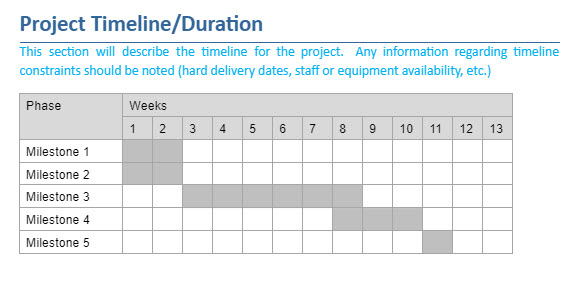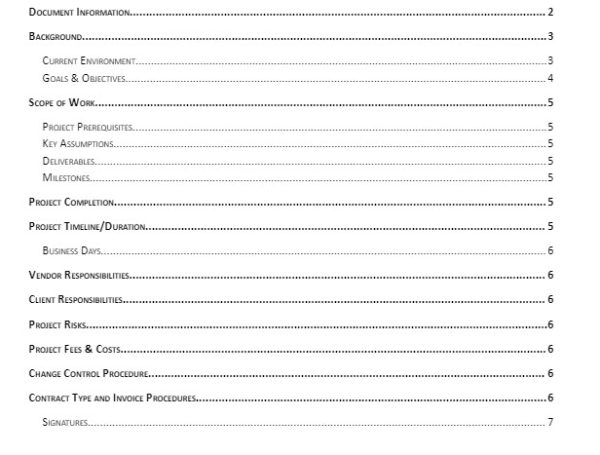The SoW serves as a contract between the project stakeholders, including the client and the service provider, and acts as a roadmap for the entire project. We’re covering everything you need to know, including how to create a statement for work, what is in a statement of work, statement of work examples, and an easy-to-use template.
What is a Statement of Work (SoW)?
The SOW is an essential part of project management, as it sets clear expectations and defines the project’s boundaries. commonly referred to as SOW, it’s a formal document that provides a detailed description of the work to be performed in a project. It outlines the project’s scope, objectives, deliverables, timelines, and any other relevant information. It serves as a reference point for all parties involved, ensuring that everyone understands their roles, responsibilities, and deliverables. By clearly defining the project’s scope and objectives, the SOW helps prevent misunderstandings, scope creep, and disputes down the line.
Knowing how to write a statement of work is crucial for the success of any project. It must be well-defined and comprehensive, regardless of its size or complexity. A SOW provides a solid foundation for effective project planning, resource allocation, and risk management. With a well-crafted SOW in place, you can ensure that your project stays on track and that all stakeholders are aligned throughout the project lifecycle.
What is the purpose of a Statement of Work?
Typically it consists of these key elements that provide a comprehensive overview of the project that help to define the scope, objectives, deliverables, timelines, and expectations, ensuring that everyone is on the same page from the start. Let’s take a closer look at each of the elements:
1. Project Description: This section provides an overview of the project, including its purpose, goals, and objectives. It sets the context for the rest of the document and helps define its scope.
2. Scope of Work: This section outlines the specific tasks, activities, and deliverables that will be performed as part of the project. It defines the project’s boundaries and helps manage expectations.
3. Timeline: This section includes a detailed timeline for the project, including key milestones, deadlines, and dependencies. It helps ensure that the project stays on track and that all parties know its timeline.
Here’s an example of a Statement of Work Timeline

4. Roles and Responsibilities: This section defines the roles and responsibilities of all parties involved in the project. It helps to establish accountability and ensures that everyone understands their obligations.
5. Deliverables: This section lists the specific deliverables that will be provided for the project. It includes detailed descriptions of each deliverable and any associated acceptance criteria.
6. Budget and Payment Terms: This section outlines the project’s budget, including any costs, expenses, or fees associated with the project. It also includes the payment terms and conditions.
7. Change Management: This section describes how changes to the project will be managed, including the process for requesting changes, assessing their impact, and obtaining approval.
8. Acceptance Criteria: This section defines the criteria that must be met for each deliverable to be accepted by the client. It helps ensure the project meets the client’s expectations and requirements.
By including these key elements in your statement of work, you can ensure that all aspects of the project are clearly defined and understood by all parties involved.
How Do You Write a Good Statement of Work?
If you want to write a good Statement of Work that serves as a template, it can be a straightforward process that saves you time and effort in the long run. Having a pre-defined template allows you to easily create new statements of work for different projects without starting from scratch each time. Here’s a step-by-step guide to building a statement of work template:
1. Define the Structure: Start by defining the structure of your statement of work template. Determine the key elements you want to include, such as project description, scope of work, timeline, roles and responsibilities, deliverables, budget, change management, and acceptance criteria.
Here’s an example of key Statement of Work components

2. Customize the Sections: Once you have defined the structure, customize each section to fit your specific needs. Consider the unique requirements of your industry, organization, or projects, and tailor the sections accordingly. For example, if you work in a creative field, you may want to include a section on design guidelines or artistic direction.
3. Include Relevant Details: Fill in the template with relevant details for each section. Be as specific and detailed as possible, providing clear and concise information. Avoid using jargon or technical language that may be difficult for others to understand.
4. Review and Refine: Once you have completed the initial draft of your template, review it for clarity, accuracy, and completeness. Ensure that all key elements are included and that the template provides a comprehensive project overview.
5. Get Feedback: Share your template with colleagues, clients, or other stakeholders and solicit their feedback. Ask for their input on the clarity, usability, and effectiveness of the template. Incorporate their suggestions and make any necessary revisions.
6. Finalize and Save: Once you have incorporated feedback and made the necessary revisions, finalize your template. Save it in a format that is easily accessible and editable, such as a Word document or a Google Doc. Consider creating a folder or a centralized repository for all your statement of work templates for easy organization and retrieval.
By following these steps, you can create a statement of work template that meets your specific needs and streamlines the process of creating new statements of work. Our easy-to-use template provides a solid starting point and can be customized to fit your unique requirements.
Common Mistakes to Avoid in a Statement of Work
Crafting a statement of work can be a complex task, and it’s easy to make mistakes that can have a negative impact on the project. By being aware of common pitfalls, you can avoid these mistakes and create a SOW that is clear, concise, and effective. Here are some common mistakes to avoid:
1. Vague or Ambiguous Language: Using vague or ambiguous language can lead to misunderstandings and misinterpretations. Be specific and precise in your descriptions, and avoid using jargon or technical terms that may not be understood by all parties.
2. Incomplete or Inaccurate Information: Failing to include all the necessary information or providing inaccurate information can lead to confusion and delays. Ensure that all key elements are covered and that the information provided is accurate and up-to-date.
3. Lack of Clarity: A statement of work should be clear and easy to understand. Avoid using complex or convoluted sentences, and ensure that the document flows logically. Use headings, subheadings, and bullet points to improve readability.
4. Failure to Define Roles and Responsibilities: Not clearly defining the roles and responsibilities of all parties involved can lead to confusion and conflicts. Clearly outline who is responsible for each task or deliverable and ensure that everyone understands their obligations.
5. Lack of Detail in Deliverables: Failing to provide sufficient detail in the description of deliverables can result in misunderstandings and disagreements. Be specific and provide clear descriptions, including any specifications or acceptance criteria.
6. Inadequate Risk Management: Ignoring or neglecting to address potential risks and issues can have serious consequences for the project. Include a section on risk management and outline how risks will be identified, assessed, and mitigated.
7. Failure to Manage Changes: Change is inevitable in any project, and failing to manage changes effectively can lead to scope creep and delays. Include a section on change management and define the process for requesting changes, assessing their impact, and obtaining approval.
8. Lack of Communication: Effective communication is essential for the success of any project. Ensure that all stakeholders are kept informed and engaged throughout the project and that their feedback and concerns are addressed.
By avoiding these common mistakes, you can create a statement of work that is clear, comprehensive, and aligned with the project’s objectives.
Best Practices for Using a Statement of Work Template
Using a statement of work template can help streamline the process of creating comprehensive and effective statements of work. By following best practices, you can maximize the benefits of using a template and ensure that your SOW is clear, concise, and aligned with the project’s objectives. Here are some best practices to consider if you’re looking to write a good Statement of Work:
1. Customize for Each Project: While using a template can save time and effort, it’s important to customize it for each project. Tailor the template to fit the unique requirements of the project, including the industry, organization, or client.
2. Be Specific and Detailed: Provide specific and detailed.
Well-Crafted Statement of Work Examples
A well-crafted statement of work serves as a roadmap for a successful project. It clearly defines the scope, objectives, deliverables, and timelines, ensuring that both the client and the service provider are on the same page. Let’s examine some well-crafted statements of work examples to understand what makes them effective.
1. Example 1: Website Development
This statement of work example clearly outlines the website development project. It includes a detailed description of the website’s functionality, design requirements, and development milestones. It also specifies the project timeline, budget, and the responsibilities of both the client and the service provider. The statement of work leaves no room for ambiguity, ensuring a smooth collaboration between the client and the development team.
2. Example 2: Marketing Campaign
This example demonstrates a statement of work for a marketing campaign. It defines the campaign’s goals, target audience, key messaging, and the channels to be used for promotion. It also outlines the deliverables, such as social media posts, blog articles, and email newsletters, along with their expected timelines. This statement of work helps the client and the marketing team align their expectations and work towards a common goal by providing a clear roadmap for the campaign.
3. Example 3: Software Implementation
The third example showcases a SOW for a software implementation project. It details the software requirements, customization needs, and integration with existing systems. The statement of work also includes a timeline for each phase of the implementation, along with the roles and responsibilities of the client and the software provider. This comprehensive document ensures that all parties involved have a clear understanding of the project scope and objectives.
These statement of work examples highlight the importance of a well-crafted statement of work in setting clear expectations and ensuring successful project outcomes.
Tools and Resources to Help You Create a Statement of Work
Creating a statement of work doesn’t have to be daunting. It’s not difficult to write a good Statement of Work. With the right tools and resources, you can streamline the process and ensure that your SOW is comprehensive and effective. Here are some tools and resources that can be invaluable in crafting the perfect statement of work.
1. Easy-to-Use SoW Template
Our easy-to-use statement of work template is the ultimate tool for effortlessly crafting the perfect statement of work. It provides a structured framework that covers all the essential elements, including project goals, deliverables, timelines, and expectations. By using our template, you can save time and ensure that your statement of work is professional and comprehensive.
Download our Statement of Work template or other templates here
2. Project Management Software
Project management software can be a valuable resource for creating and managing your statement of work. These tools often include features specifically designed for creating and tracking project documentation. They allow you to collaborate with team members, track progress, and ensure that everyone is on the same page throughout the project.
3. Industry-Specific Templates
Depending on your industry, there may be industry-specific templates available that can serve as a starting point for your statement of work. These templates are tailored to the unique requirements of specific industries, making it easier for you to create a statement of work that aligns with industry best practices.
4. Professional Writing Services
Professional writing services can be a great option if you’re short on time or lack the expertise to create a statement of work. These services have experienced writers who specialize in creating high-quality statements of work that are tailored to your specific needs. By outsourcing this task, you can ensure that your statement of work is well-crafted and meets professional standards.
By utilizing these tools and resources, you can simplify the process of creating a statement of work and ensure that it accurately reflects the scope and objectives of your project.
It’s essential to write a good Statement of Work that sets clear expectations and ensures the success of your projects. Our easy-to-use template takes the hassle out of creating a comprehensive and effective statement of work, allowing you to focus on delivering outstanding results for your clients. By utilizing tools like project management software and industry-specific templates, you can streamline the process and ensure that your statement of work is professional and comprehensive.
Don’t let the statement of work become a stumbling block – revolutionize the way you approach it and start seeing the benefits today with our easy-to-use template. By following some statement of work examples in your industry and downloading our Statement of Work Template or other templates you can make project management more manageable!


